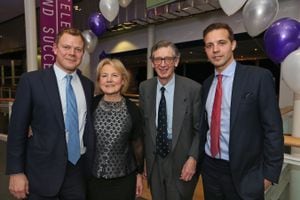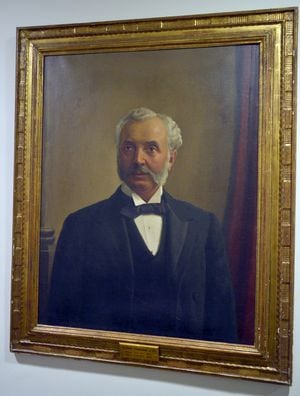Express & Star and Shropshire Star owner Alan Graham dies aged 79
The owner of the Express & Star and Shropshire Star has died aged 79 after a period of illness.

Alan Graham was the great-grandson of the founder of the Express & Star Thomas Graham, who set up the newspaper in the 1880s as part of a group that included Scottish-American millionaire Andrew Carnegie.
He played a crucial role in the company’s expansion to become the leading evening newspaper publisher in the country, with a combined daily circulation in excess of 350,000.
He also pioneered the use of colour printing 22 years before Fleet Street finally caught up.
Mr Graham led the consortium that launched Beacon Radio 303, now Free Radio, in 1976. And he also brought the Jersey Evening Post and Guernsey Press into the company’s list of titles after buying them in 2003.
Stars News shops were launched in 1967 in Hadley and they grew to a chain of 150 convenience stores, employing 3,000, before being sold to Midcounties Co-operative in 2007.
And Mr Graham launched Precision Colour Printing in the 1980s, a company that continues to thrive today as a specialist printer of magazines and catalogues.
Mr Graham continued to be actively involved in the production of the group’s newspapers until shortly before his death, and was a familiar face at the Express & Star office in Queen Street, Wolverhampton, and the Shropshire Star base at Ketley.
He was just 20 years old when he was handed a leading role in the formidable task of launching Britain’s first new evening newspaper since the Second World War.
Not only that, but the Shropshire Star would also be the first newspaper in the country to print in colour.
The Graham family spotted Shropshire’s potential as a future growth area with the designation of Dawley New Town in January 1963, and Alan Graham was appointed a director of the embryonic Shropshire Star and Journal Ltd that year.
A suitable site for the new paper’s headquarters was identified at Ketley Farm in April 1963, and Mr Graham was appointed as the plant’s general manager.

The new building was completed in just nine months, and Mr Graham was in charge of introducing new technology, sourced from both the United States and Denmark, to put the company at the forefront of the industry.
He recalled that the new hi-tech printing presses caused a few problems in the early days.
“I think I was the first general manager because with all the new technology there wasn’t anybody else who knew anything about it and we all had to learn as we went,” he said in a 2014 interview. “It was a most exciting time.”
He said it was the 1967 foot-and-mouth epidemic that really convinced people in Shropshire of the need for a daily newspaper dedicated to the county, and from then on sales grew rapidly.
“It might sound strange but I think the biggest breakthrough for the Shropshire Star and its readers was that foot-and-mouth outbreak where we were able to be of support,” he said. “We had the idea of printing a map of where outbreaks had been and where new ones were.
“It seems silly to say but that was the only information farmers and local people had and I think they were grateful our drivers got through as well. We felt we had really been able to help out in a practical way.”

The new technology pioneered by the Shropshire Star was then adopted by the Express & Star, leading the two titles to dominate the regional newspaper industry.
But it was not until 1986, with the launch of the short-lived Today newspaper, that colour technology reached Fleet Street.
Along with his father Malcolm and older brother Douglas, Mr Graham was also at the forefront of another technological revolution for the industry in the 1980s when the Express & Star became the first newspaper in the country to introduce an electronic editorial system.
More than £500,000 had been invested in the new Press 11 computer system, introduced in December 1980, which meant that instead of typing stories on paper and then sending them to a composing room for typesetting, reporters could now simply write their stories on a computer screen which would send it down the telephone line to the newsdesk where the pages could be prepared electronically.

This technology, which it was estimated could save 10 minutes on every story produced, led to the Express & Star being featured on The Money Programme, where it was compared favourably to The Times in London which was struggling with old technology. It was not until the mid-1980s that such technology was adopted by the national press.
The new technology was a major factor in Mr Graham receiving the 1988 Newspaper Focus award for Outstanding Achievement in a ceremony at London’s Grosvenor Hotel, which was hosted by the BBC’s John Humphrys and attended by former chancellor of the exchequer Lord Healey.
The following year the Express & Star saw its circulation pass the 250,000 mark, with the Shropshire Star selling 100,000, a milestone that was celebrated with a party at Weston Park.
Another proud moment came in 1997, when Mr Graham hosted a visit by HRH the Prince of Wales to the company’s head office in Wolverhampton.
Mr Graham later received a letter from the Prince praising the company’s ‘family atmosphere’.
The Prince wrote: “Seeing my picture on the front page of your first edition only 45 minutes after my arrival was most impressive.
“I was particularly struck by the fact that many of the people I met had been with you for a number of years and clearly enjoyed their jobs tremendously.
“It was marvellous to experience the atmosphere of a proper ‘family’ firm!”
Mr Graham was also a director of Press Association, and a leading member of The Newspaper Society.
He continued to strive to diversify the business. As well as its daily and weekly newspapers, the Claverley Group now owns Kennedy Publishing, a children’s magazine publisher that produces more than 30 popular titles. It also runs Cubiquity, a creative design and print procurement agency that provides marketing services for a number of leading national and global brands.
In his spare time he was an avid yachtsman and ocean racer, who formed part of the UK team that won the Sydney-Hobart Southern Cross Cup in 1973 on his 44ft sailing yacht Superstar. He was also a passionate country sportsman.
He is survived by his wife Angela, daughters Lavinia and Charlotte and sons Tom and Edward, who have both followed him into the family business.





